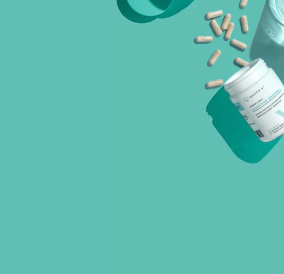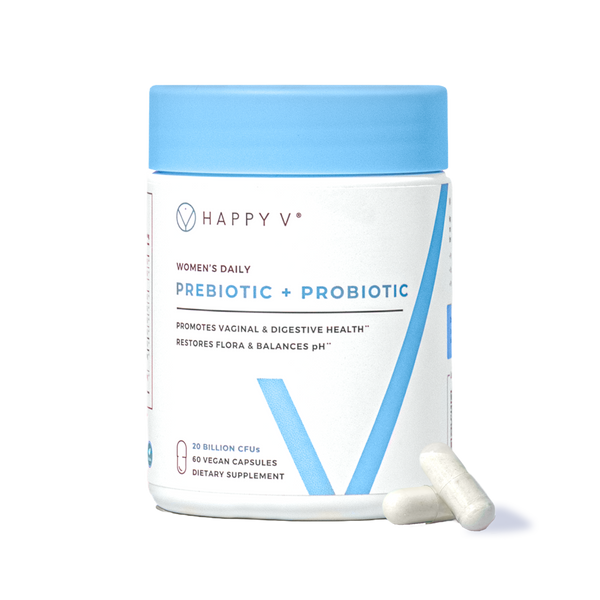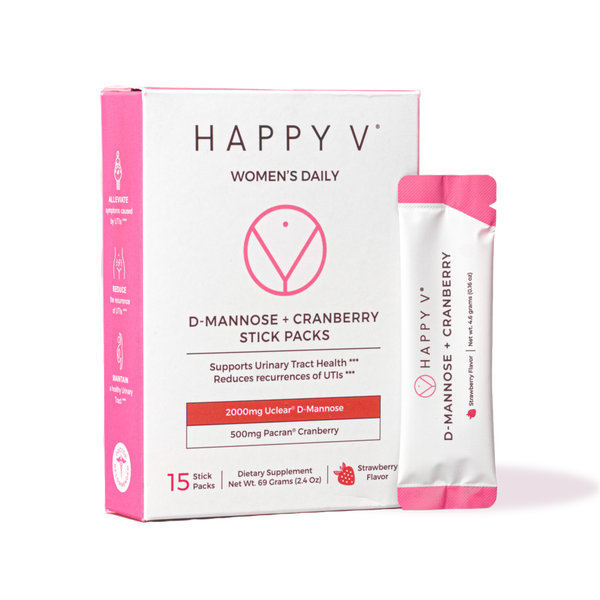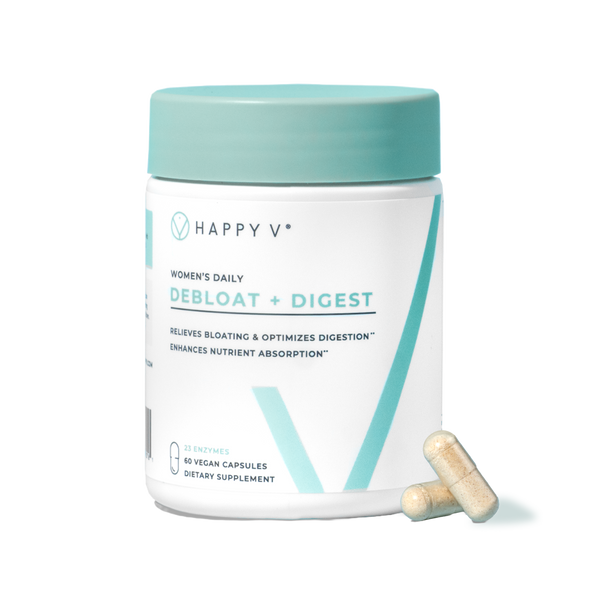- Fact Checked
- June 11, 2025
- 11 min read
Table of Contents
Bacterial vaginosis (BV) is one of the most common vaginal infections, especially among women of childbearing age. It’s a condition where the balance of vaginal bacteria shifts — the good bacteria, mainly lactobacilli, decrease, and bad bacteria, such as Gardnerella vaginalis, increase. This overgrowth is called vaginal dysbiosis and can result in vaginal inflammation.
BV is more common than both yeast infections and trichomoniasis and is the most frequent type of vaginitis1. It’s not a sexually transmitted disease (STD), but sexual activity, new or multiple sexual partners, and unprotected sex are all considered risk factors. BV also tends to recur — many women experience recurrent bacterial vaginosis several times per year2.
If you’ve dealt with recurring BV, you know how frustrating it can be. Antibiotic treatment works, but often only temporarily — many women report the infection comes back just weeks later. So, naturally, a lot of people turn to home treatments. But which ones are actually helpful, and which might do more harm than good?
Let’s explore every major home remedy in simple, human terms — backed by research — so you can make the best choice for your body.
This post is for informational purposes only and does not constitute medical advice. See full disclaimer below.
Can You Treat BV Without Antibiotics?
Let’s get one thing straight right off the bat: we aren’t anti-antibiotics. In fact, life could look pretty bleak without them, given that scientists estimate there are more bacteria on Earth than stars in our galaxy. Antibiotics are essential — especially for life-threatening infections. But what about non-life-threatening conditions like bacterial vaginosis?
In these cases, antibiotics are sometimes referred to as "weapons of mass destruction" in the pharmaceutical world. Why? Because they don’t just kill the bad bacteria — they wipe out the good ones too3. While this is sometimes necessary, repeated use of antibiotics for BV can lead to bacterial resistance, damage to healthy bacteria, and recurring infections.
That’s why many women experiencing recurrent BV feel stuck in the infection-antibiotic cycle — temporary relief followed by reinfection. Fortunately, there are home-based, natural BV treatments that may help you break that cycle for good.
Yes, it’s possible — especially for people with mild or recurring BV who want to avoid constant antibiotics. While antibiotics like metronidazole, tinidazole, and clindamycin are still the standard treatment for bacterial vaginosis, they often disrupt not just the bad bacteria but also the good ones, which can leave your vaginal microbiome more vulnerable4.
According to the Centers for Disease Control and Prevention (CDC), antibiotic treatment is the first line of care — but there is increasing interest in natural or over-the-counter alternatives for managing recurrent BV and minimizing side effects5.
Many women turn to home remedies out of embarrassment, frustration with the cycle of antibiotic treatment, or a desire for natural alternatives. Unfortunately, most studies on these alternative treatments are either small or poorly controlled. A number of women even report their symptoms worsened after trying self-help remedies6. More high-quality research is needed to better understand what works — and what doesn’t.
Short answer: Yes — if you focus on restoring balance, not just killing off bacteria.
Remedies That Might Work (and What the Research Says)
1. Probiotics (Especially with Lactobacillus HN001 and LA-14)
Probiotic supplements are one of the most popular and promising natural treatments for BV. The idea is simple: you add good bacteria back into your system to crowd out the bad ones and restore your natural balance of bacteria 7.
Specifically, the strains Lactobacillus rhamnosus HN001 and Lactobacillus acidophilus LA-14 have been studied for their ability to colonize the vagina after being taken orally. In a controlled trial, both were detected in vaginal swabs after consumption8.
In studies, these probiotics:
- Were found in vaginal swabs after oral use
- Produced hydrogen peroxide and lactic acid, which kill or inhibit bad bacteria9
- Helped lower vaginal pH back to healthy levels10
A 2019 systematic review concluded that probiotic therapy might offer both short- and long-term benefits in treating BV11. However, results across studies have been mixed, and further research is still needed to evaluate their overall effectiveness.
Bottom line: A high-quality probiotic supplement with these strains can help treat BV and prevent it from coming back. They're especially useful as part of women’s health routines, offering benefits for both vaginal and gut health.
2. Boric Acid Suppositories
Boric acid is a mild antiseptic that has been used for decades to treat vaginal infections, including vulvovaginal candidiasis12. It works by acidifying the vagina and creating an environment where bad bacteria can’t thrive.
Research shows that when used daily (600 mg for 21 days), boric acid can help clear up BV — especially in women who get it frequently13. One systematic review found it was effective in up to 92% of cases.
As of 2015, there was no completed clinical trial evaluating boric acid’s effectiveness specifically for BV, although protocols were being developed. Some researchers have explored its role as an add-on to suppressive therapy in recurrent bacterial vaginosis.
Important: Boric acid doesn’t replace the good bacteria — so pairing it with a probiotic is ideal.
Safety note: Don’t use boric acid if you’re pregnant (especially in the first trimester), and don’t take it orally. Pregnant women should always consult a gynecologist or OB/GYN before using any intravaginal BV treatment.
3. Yogurt (Eaten, Not Inserted)
Yogurt contains live bacteria, particularly lactobacilli, which are the same kind of healthy bacteria found in a healthy vagina. Eating yogurt regularly may help maintain or improve your vaginal microbiome by supporting your gut health, which is connected to your vaginal health14.
In one study, women who ate yogurt containing Lactobacillus acidophilus experienced fewer recurrences of both yeast infections and BV compared to those who ate pasteurized yogurt15. Importantly, yogurt has little potential for harm when eaten and may offer mild protective effects.
Some women have tried inserting yogurt vaginally to treat BV or yeast infections, but this is not recommended. It’s not sterile and can introduce other microbes into the genital area.
Stick to eating it. Look for plain, unsweetened yogurt with live active cultures.
4. Garlic Supplements
Garlic is known for its antibacterial properties. Some studies have shown that taking garlic supplements may reduce BV symptoms or help prevent it. Garlic contains allicin, a compound that has been shown to kill harmful bacteria16.
In some comparisons with metronidazole, garlic supplements showed slight symptom relief but were not curative. Participants in one study said symptoms lessened, but didn’t fully resolve.
Important: Never insert raw garlic into your vagina. Stick with oral supplements.
5. Hydrogen Peroxide Rinses
Some women use diluted hydrogen peroxide as a vaginal rinse to reduce BV symptoms. Hydrogen peroxide is a natural disinfectant and can kill bad bacteria, including some BV-associated strains.
However, clinical evidence is limited and mixed. While one participant in a study reported immediate relief, others found their symptoms worsened. Overuse or improper dilution can irritate the vaginal lining and disrupt the microbiome17.
Hydrogen peroxide may temporarily reduce the fishy odor that is one of the most common symptoms of BV, but it is not a substitute for a full course of antibiotics when clinically indicated.
Use with caution, and never undiluted. Talk to your doctor before trying this method.
6. Apple Cider Vinegar Baths
Apple cider vinegar is popular in the natural health world for its antimicrobial and pH-balancing properties. Some people believe that adding it to a warm bath can help rebalance the vagina’s pH.
But there’s no strong evidence to back this up, and the acidity of vinegar could irritate sensitive skin. Vinegar-based douching is especially discouraged by gynecology professionals. In fact, a systematic review found a weak positive correlation between douching and BV.
Bottom line: Might help temporarily, but don’t rely on it. Never douche with vinegar.
7. Tea Tree Oil (Diluted Only)
Tea tree oil is a powerful essential oil with antifungal and antibacterial effects18. Some over-the-counter products use it in vaginal suppositories to target infections, including bacterial vaginosis and yeast infections.
However, many women report irritation or allergic reactions, and evidence supporting its use is mostly anecdotal. Use only highly diluted formulas from trusted sources — and always consult a healthcare provider first.
Verdict: Some potential, but high risk. Better alternatives exist.
8. Dietary Changes and Fermented Foods
Bad bacteria feed on sugar, saturated fat, and alcohol. Cutting down on these can support your vaginal microbiome and help reduce the risk of BV.
Eating more fermented foods like kefir, sauerkraut, kimchi, and miso may introduce helpful bacteria19. While evidence is limited, these changes are safe and supportive of gut and vaginal health.
Helpful tip: Consider diet as a supportive tool — not a standalone cure.
9. Hygiene and Lifestyle Habits
Good hygiene can help prevent BV, especially if it’s recurring. Women often try frequent showers, changing underwear, or using products like perfumes, wipes, or sprays — but these can be irritating and may worsen symptoms.
Recommended practices:
- Avoid douching — studies link it to higher BV risk
- Use only water or mild soap on your vulva (never inside the vagina)
- Wear breathable cotton underwear
- Pee and rinse with warm water after sex
- Avoid scented products
- Use protection with new sexual partners
- Do not use tampons soaked in home remedies — they are not medically recommended
These won’t cure BV on their own, but they create a healthier environment where good bacteria can thrive.
Common Antibiotics Prescribed for BV
Most doctors begin BV treatment with a course of antibiotics, especially if it’s a first-time infection or symptoms are severe. Here are the most common options:
| Antibiotic | Form | Dosage | Side Effects |
| Metronidazole (Flagyl, MetroGel) | Oral pill or intravaginal gel |
|
Nausea, vomiting, metallic taste, loss of appetite, headache20 |
| Tinidazole (Tindamax) | Oral pill |
|
Nausea, dizziness, metallic taste, constipation, alcohol intolerance21 |
| Clindamycin (Cleocin, Clindesse) | Oral capsule, vaginal cream, or suppository |
|
GI discomfort, vaginal irritation, possible condom degradation22 |
| Secnidazole (Solosec) | Oral granules (single dose) | 2g mixed with soft food and consumed in one sitting |
Nausea, headache, diarrhea, metallic taste23 |
While these are effective, they don’t discriminate between harmful and healthy bacteria — which is why they often need to be paired with a probiotic or followed by vaginal microbiome support.
When to See a Doctor
If symptoms of BV don’t go away after trying these approaches — or if you experience burning, discomfort, vaginal itching, or unusual vaginal discharge — it’s time to talk to your doctor or gynecologist.
Remember, untreated BV can lead to:
- Pelvic inflammatory disease
- Increased risk of sexually transmitted infections like chlamydia and gonorrhea
- Pregnancy complications like low birth weight or early labor
BV may also increase your susceptibility to other vaginal infections and affect female partners. Always consult a provider before trying a new treatment, especially if you’re pregnant.
For more clinical guidance, review the latest gov fact sheets or speak to your doctor about your BV treatment options.
Final Thoughts: A Smarter Way to Treat BV
You don’t have to rely on antibiotics forever. Treating BV at home is possible when you:
- Rebuild your vaginal flora with probiotic supplements (with strains like LA-14 and HN001)
- Use boric acid suppositories to reset pH
- Adjust your diet and hygiene habits to support good bacteria
- Use safe, informed home treatments as needed
Want a probiotic designed just for your vaginal health? Happy V’s Prebiotic + Probiotic uses the exact strains studied for BV — plus a prebiotic to help those good bacteria thrive.
You deserve to feel confident and comfortable in your body. Treating BV shouldn’t be confusing — and now, it doesn’t have to be.
This article is for informational purposes only and is not intended as medical advice. Please consult your healthcare provider before starting any new treatment.









